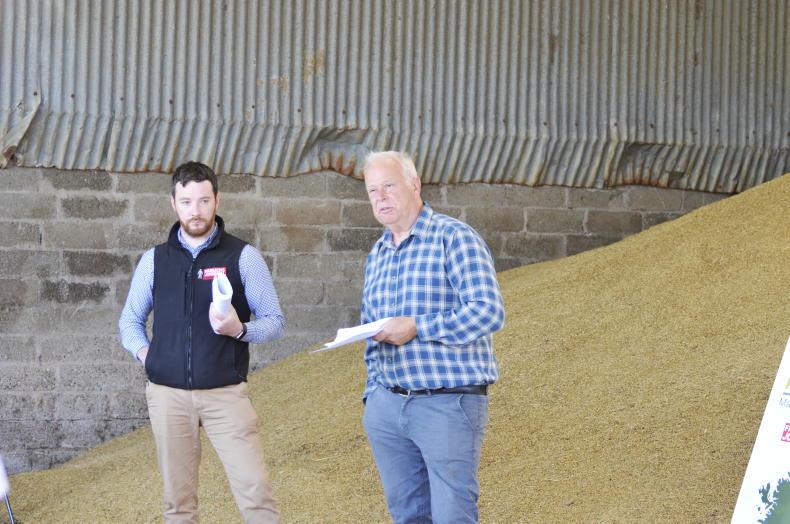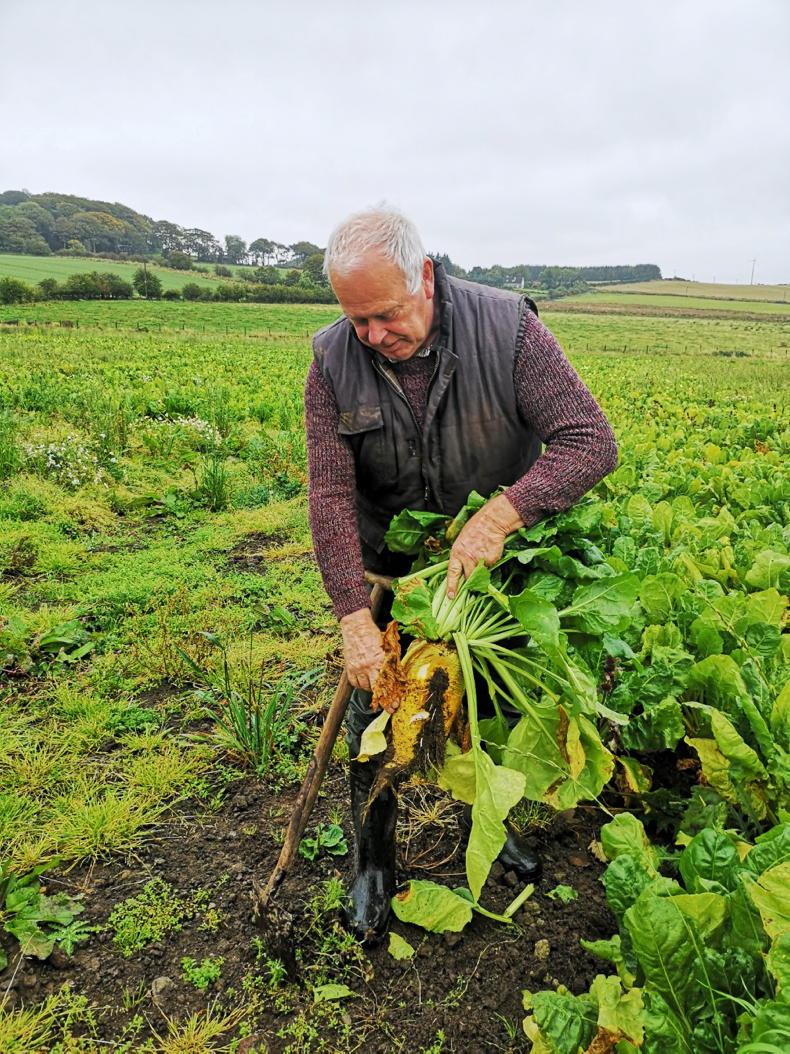We first heard of the programme when we went to an open evening at the mart and one of the auctioneers asked if we would be interested. It was Fiona who first encouraged us to get involved in the programme. She was keen for us to grow the business and learn new ideas. At the time, we needed to look at the suckler cow enterprise, as we were not making a lot of money from it.
We had also recently introduced a ewe flock and were keen to get more from them.

The Biffens worked hard to reduce he cost of winter as discussed at this farm meeting.
From the outset, the plans were bold. We knew we would not be able to do everything straight away, but Declan Marren and Robert Gilchrist were good at feeding us changes bit by bit to ensure the plans did not come across as too daunting.
Forage crop success
The biggest change we undertook was establishing forage crops to cheapen the cost of winter. We found this was the key to the whole programme and has made a big difference to the cost of wintering the cows. Stubble turnips, hybrid rape and now fodder beet have all been tried and we will use a combination of them in the coming years.

Andrew Biffen has been happy with the success of growing fodder beat on the farm for cattle and sheep.
The first year saw us outwinter 40 cows on forage crops, but this year, there were only 20.
Moving to fodder crops has meant we have stopped growing oilseed rape. We are also using the fodder crops as a break crop on the non-cropped grassland area that is not fit for cereals.
We also found that getting the soil right was important. Prior to the programme, we did not apply much lime, but now we are treating around 40-50ac per year, and it is having a major impact on crop yields.
We had let the pH of the soil get too low before the programme and I would recommend people get their farm soil tested to understand how to get the best from the land.
Some of our poorer land took a lot of lime and we have really seen it green up and put some sweetness back into the grass. Lime really does give you your money back in improved growth and a reduced need for fertiliser.
Proper rotation
We used to manage the farm as two separate blocks of ground – one was used for growing crops and the other for grass and the two did not interact.
Since we joined the programme, we have better integrated them, which has improved both soil health and farm output. While a farm in full rotation is expensive, with additional fencing and water troughs, it is something we will continue to work towards.
Business profitability has trended upwards through the programme. However, we did see some exceptional weather over the four years. We had one of the driest droughts and one of the wettest autumns and winters that I can remember. These extreme conditions make it difficult to properly measure the impact of the programme, but I can see the trend is upwards.
Cow breeds
We wanted to improve the calving ease of the cows, so we bought a Stabiliser bull to get some Stabiliser heifers out of our own cows. We are not getting any younger and do not want to be out all-night calving cows.
The heifers have been bred pure and kept as replacements, while the males are entire and we are finishing them on home-grown grain. As it stands, we are looking at keeping two-thirds of the 120-cow herd as Simmental and Limousin crosses and the remaining third as Stabilisers.

The suckler herd introduced a Stabliser bull to make calving easier
The continental cows will produce steers and heifers for the store ring. With a 450kg store animal making over £1,000, it is a good market to sell into.
Silage quality
Throughout the programme, we have tried to improve the quality of the silage we make. Despite the exceptional weather conditions, we have achieved this. We are also trying to incorporate more clover in our grass leys to reduce fertiliser use and improve feed quality.
Sheep changes
The programme also brought some major changes to the ewe flock. Previously, we were running a flock of Scotch halfbred ewes and we purchased replacement gimmers each year. Now, we have a closed flock of composite hybrid sheep.

Fiona pushed the flock on by changing breed type and finishing more lambs off grass.
The change of breed has made lambing easier and the closing of the flock has saved us a lot of money, as we no longer need to buy in gimmers. This is only our second lambing after the changes, so we are still assessing performance, but so far so good.
Last year, all the lambs were away by Christmas and the majority were sold off grass. We have retained 90 ewe lambs for replacements for this year, which will allow us to build numbers up to 350.
We have also started to rotational graze, mainly with the sheep. This change was a challenge, as we did not know what was going to happen and could see extra work and costs. However, now that we are doing it, the costs and effort have paid off with improved performance.
The meetings we went to were good. I would particularly recommend younger farmers getting involved. I really enjoyed working with the advisors and my ‘confrontations’ with Robert challenged my thinking and helped the farm progress.
We first heard of the programme when we went to an open evening at the mart and one of the auctioneers asked if we would be interested. It was Fiona who first encouraged us to get involved in the programme. She was keen for us to grow the business and learn new ideas. At the time, we needed to look at the suckler cow enterprise, as we were not making a lot of money from it.
We had also recently introduced a ewe flock and were keen to get more from them.

The Biffens worked hard to reduce he cost of winter as discussed at this farm meeting.
From the outset, the plans were bold. We knew we would not be able to do everything straight away, but Declan Marren and Robert Gilchrist were good at feeding us changes bit by bit to ensure the plans did not come across as too daunting.
Forage crop success
The biggest change we undertook was establishing forage crops to cheapen the cost of winter. We found this was the key to the whole programme and has made a big difference to the cost of wintering the cows. Stubble turnips, hybrid rape and now fodder beet have all been tried and we will use a combination of them in the coming years.

Andrew Biffen has been happy with the success of growing fodder beat on the farm for cattle and sheep.
The first year saw us outwinter 40 cows on forage crops, but this year, there were only 20.
Moving to fodder crops has meant we have stopped growing oilseed rape. We are also using the fodder crops as a break crop on the non-cropped grassland area that is not fit for cereals.
We also found that getting the soil right was important. Prior to the programme, we did not apply much lime, but now we are treating around 40-50ac per year, and it is having a major impact on crop yields.
We had let the pH of the soil get too low before the programme and I would recommend people get their farm soil tested to understand how to get the best from the land.
Some of our poorer land took a lot of lime and we have really seen it green up and put some sweetness back into the grass. Lime really does give you your money back in improved growth and a reduced need for fertiliser.
Proper rotation
We used to manage the farm as two separate blocks of ground – one was used for growing crops and the other for grass and the two did not interact.
Since we joined the programme, we have better integrated them, which has improved both soil health and farm output. While a farm in full rotation is expensive, with additional fencing and water troughs, it is something we will continue to work towards.
Business profitability has trended upwards through the programme. However, we did see some exceptional weather over the four years. We had one of the driest droughts and one of the wettest autumns and winters that I can remember. These extreme conditions make it difficult to properly measure the impact of the programme, but I can see the trend is upwards.
Cow breeds
We wanted to improve the calving ease of the cows, so we bought a Stabiliser bull to get some Stabiliser heifers out of our own cows. We are not getting any younger and do not want to be out all-night calving cows.
The heifers have been bred pure and kept as replacements, while the males are entire and we are finishing them on home-grown grain. As it stands, we are looking at keeping two-thirds of the 120-cow herd as Simmental and Limousin crosses and the remaining third as Stabilisers.

The suckler herd introduced a Stabliser bull to make calving easier
The continental cows will produce steers and heifers for the store ring. With a 450kg store animal making over £1,000, it is a good market to sell into.
Silage quality
Throughout the programme, we have tried to improve the quality of the silage we make. Despite the exceptional weather conditions, we have achieved this. We are also trying to incorporate more clover in our grass leys to reduce fertiliser use and improve feed quality.
Sheep changes
The programme also brought some major changes to the ewe flock. Previously, we were running a flock of Scotch halfbred ewes and we purchased replacement gimmers each year. Now, we have a closed flock of composite hybrid sheep.

Fiona pushed the flock on by changing breed type and finishing more lambs off grass.
The change of breed has made lambing easier and the closing of the flock has saved us a lot of money, as we no longer need to buy in gimmers. This is only our second lambing after the changes, so we are still assessing performance, but so far so good.
Last year, all the lambs were away by Christmas and the majority were sold off grass. We have retained 90 ewe lambs for replacements for this year, which will allow us to build numbers up to 350.
We have also started to rotational graze, mainly with the sheep. This change was a challenge, as we did not know what was going to happen and could see extra work and costs. However, now that we are doing it, the costs and effort have paid off with improved performance.
The meetings we went to were good. I would particularly recommend younger farmers getting involved. I really enjoyed working with the advisors and my ‘confrontations’ with Robert challenged my thinking and helped the farm progress.










 This is a subscriber-only article
This is a subscriber-only article











SHARING OPTIONS: